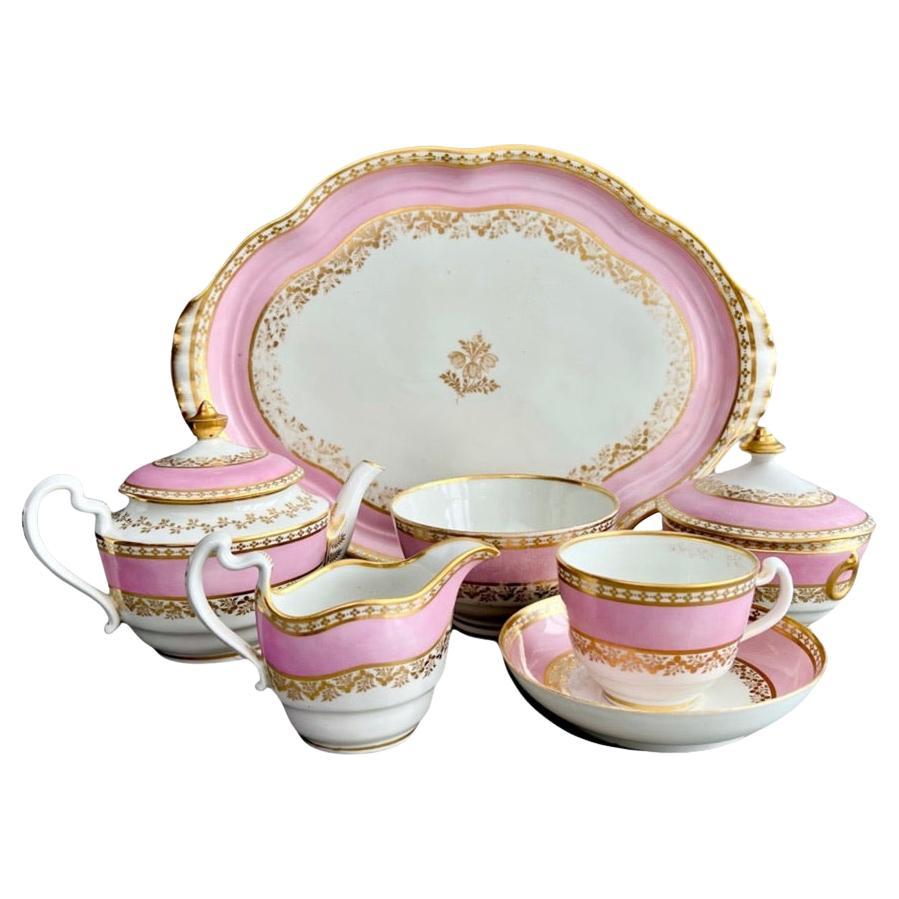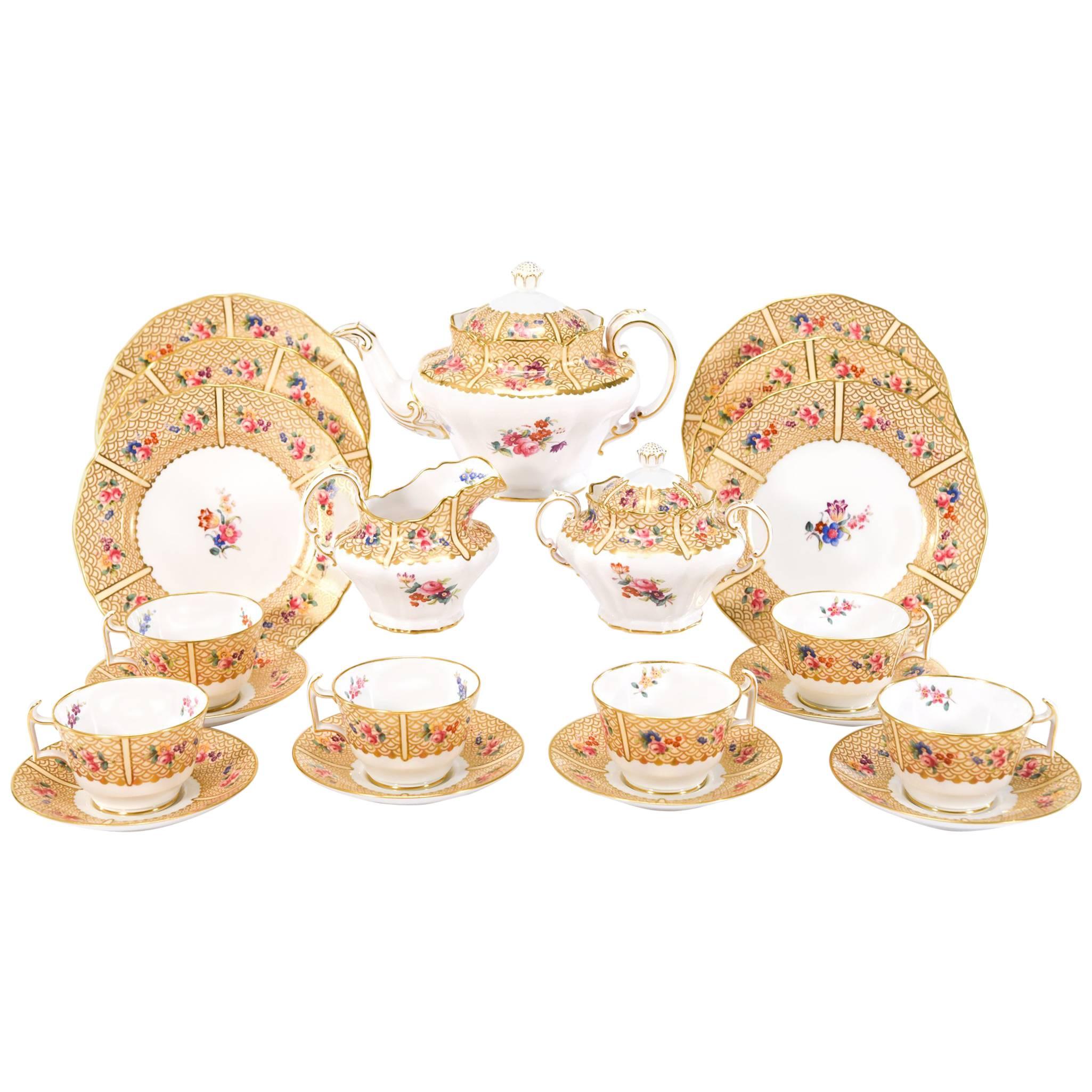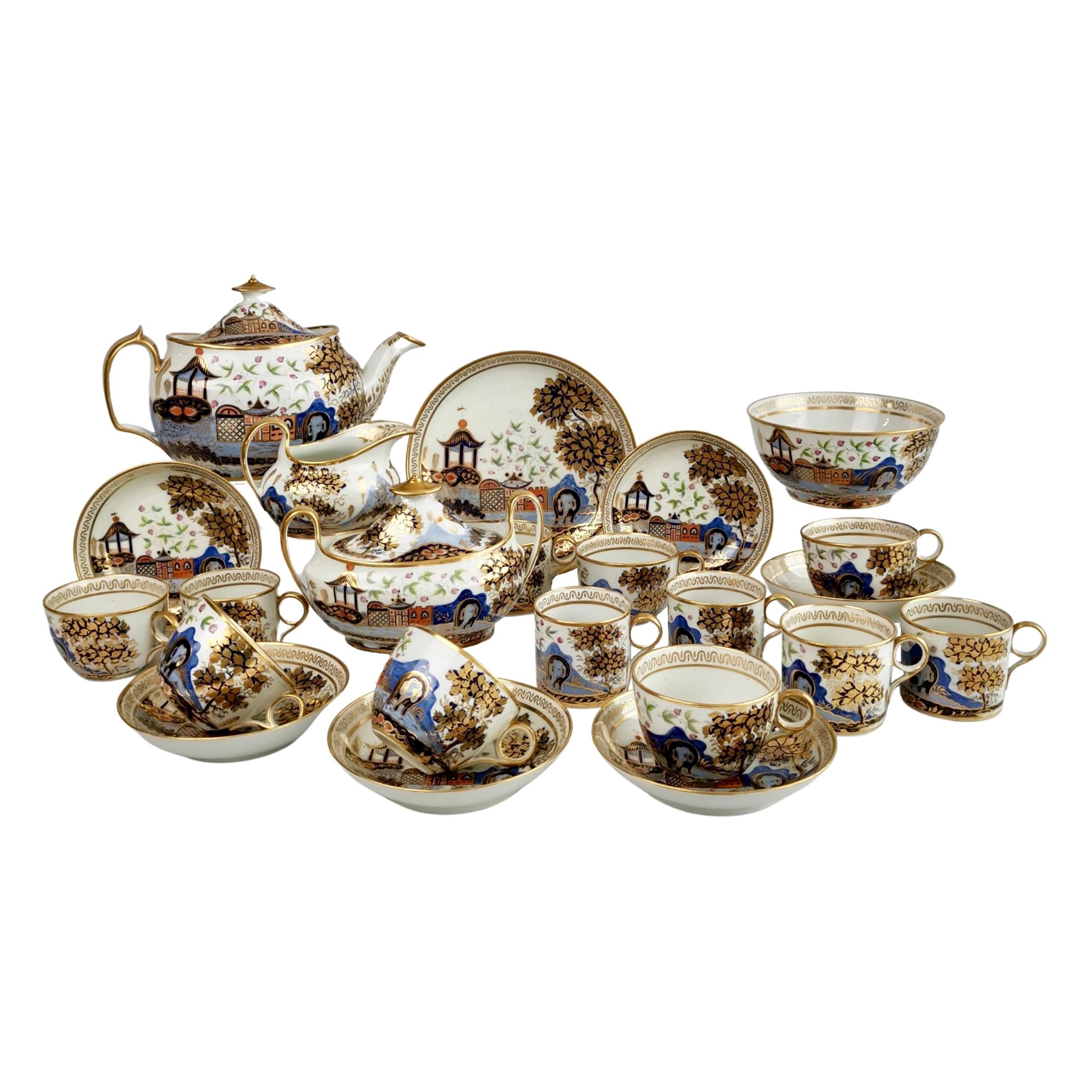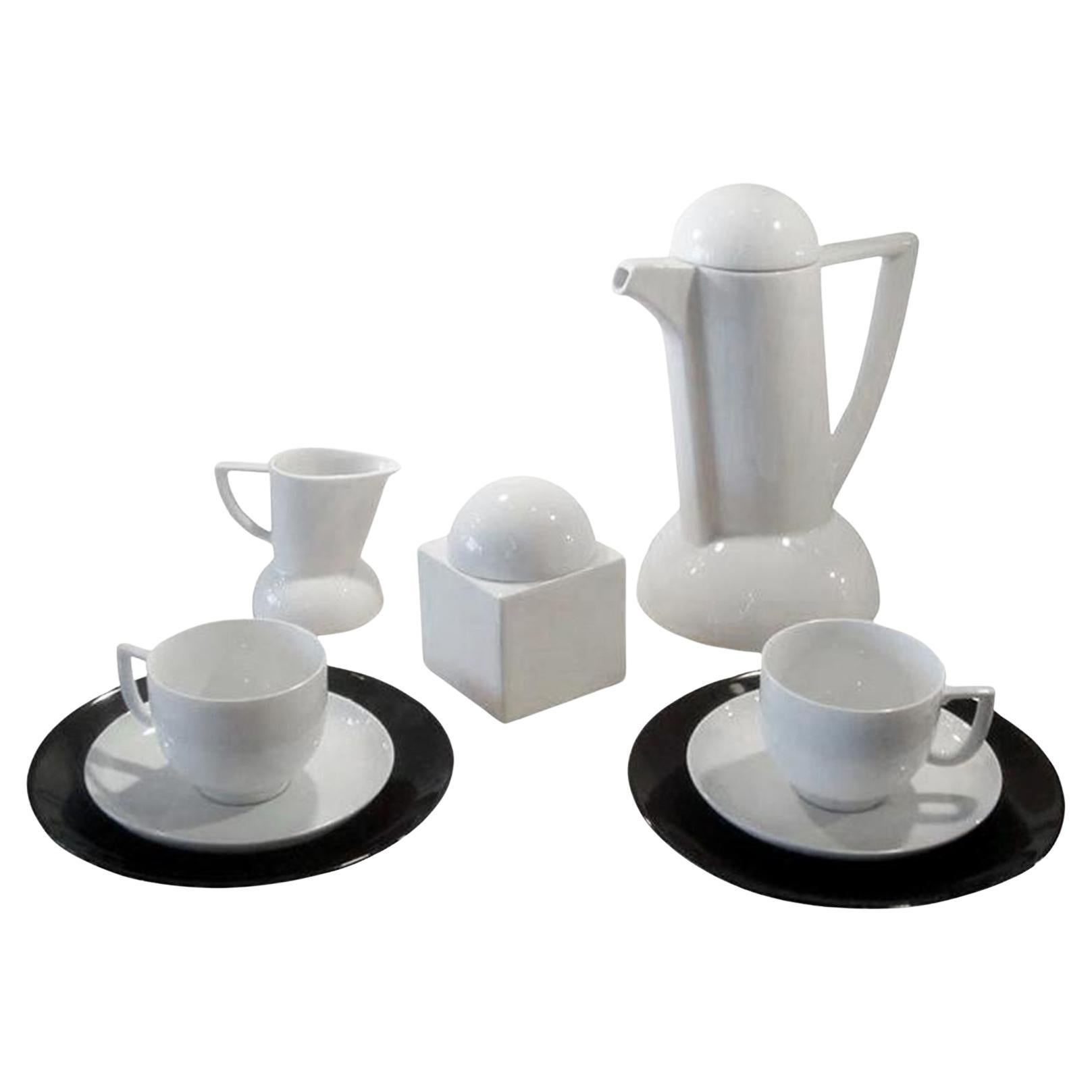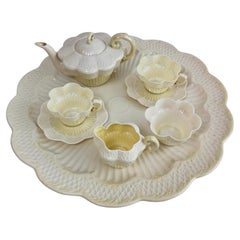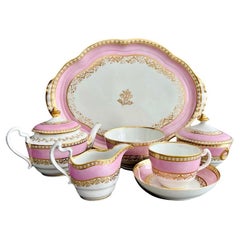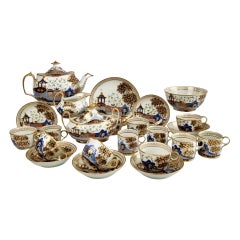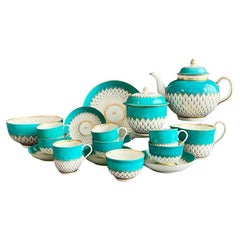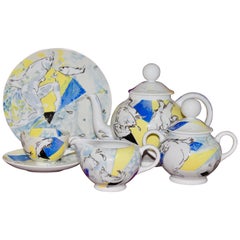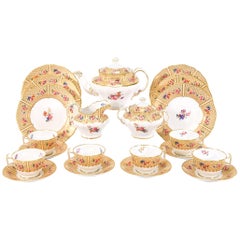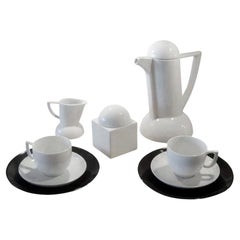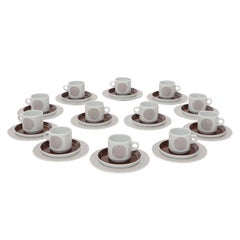Items Similar to Belleek Cabaret Tea Set for Two, Cream Grass Pattern, Victorian 1863-1891
Want more images or videos?
Request additional images or videos from the seller
1 of 17
Belleek Cabaret Tea Set for Two, Cream Grass Pattern, Victorian 1863-1891
About the Item
This is a beautiful and very rare Belleek cabaret set in the Grass design, consisting of a teapot, two teacups and saucers, a milk jug and a lidded sugar bowl, all placed on a large tray. All items carry the 1st Black Mark, which was used between 1863 and 1891.
It is extremely rare to come across an entire cabaret set of these antique items, particularly when in such fabulous condition, so this is a rare opportunity!
If you ever thought Belleek fine china looks, sounds and feels unique, you are right. There is a back story to this extraordinarily fine Irish eggshell porcelain, which has an unusually high amount of "frit" and therefore is thinner and finer than any other china.
Pottery in Belleek (in the now Northern-Irish area of Fermanagh) had started in 1849 with John Caldwell Bloomfield, who was a wealthy land owner. During the Irish famine he realised that unless he would find a way for his tenants to make a profit off the land, they would starve. Agriculture had become impossible due to the agricultural diseases caused by mono culture at that time, and the political unrest in response to British colonial rule. This a million people to starve and another million to leave; the population had halved within a decade. As an amateur mineralogist, Bloomfield realised that his land had exactly the right mineral deposits to be used as clay for porcelain. He involved several investors and scientists and after many years of research, trial, error, the building of a railway line to import coal from England, and building a factory, the Belleek pottery resulted, employing the local people and soon producing the finest china made with clay from the Belleek area.
What had started as a way to fend off famine among the local tenants had became a story of incredible success by the 1880s as Queen Victoria fell in love with the fine white china and the many homely, slightly bizarre but nature-loving designs; this was different from English tradition, yet it was very much to the taste of the British who had developed a real love for home-made fine china since it was introduced in the late 18th Century. Soon the English nobility started to place big orders and the pottery is still flourishing today and selling its wares the world over, while in England most potteries have long disappeared.
The Grass series is one of the many Belleek designs that were inspired by nature rather than by fashion: there are sea shells, froth, seaweeds, tree roots and bark, corals and woven baskets. The Grass design is a bit rarer than many of the more nautical designs, and particularly as a cabaret set it is hard to come by. The teapot has a wonderful "duck spout", much like the famous English teapots from the 1840s, with a grinning duck's face as a spout. And it has an unusual shape: it is a kettle. Each item has grass blades and seeds embossed on it, and picked off in muted and slightly iridescent colours. The finials of the teapot and sugar pot, as well as the little handles of the sugar pot, look like cut-off wheat sheafs. The bottom of the tray is like a woven basket.
On the inside of the teapot cover is a message with instructions on how to brew tea; this is how Belleek educated second-generation Irish Americans who liked to buy Belleek porcelain but hadn't necessarily learned how to brew tea the proper way.
CONDITION REPORT The set is in fabulous antique condition without damage, repairs, crazing or significant wear except a tiny chip off the lower part of the duck spout, and a little chip off the rim of the milk jug. Neither affects their usability and they are hard to notice. As in many Belleek tea sets, the colours on the various items are slightly different.
Antique porcelain is never perfect. Kilns were fired on coal in the 1800s and early 1900s, and this meant that china from that period can have some firing specks from flying particles. Makers were also known for their experimentation, and sometimes this resulted in technically imperfect results. Due to the shrinkage in the kiln, items can have small firing lines or develop crazing over time, which should not be seen as damage but as an imperfection of the maker's recipes, probably unknown at the time of making. Items have often been used for many years and can have normal signs of wear, and gilt can have signs of slight disintegration even if never handled. I will reflect any damage, repairs, obvious stress marks, crazing or heavy wear in the item description but some minor scratches, nicks, stains and gilt disintegration can be normal for vintage items and need to be taken into account.
There is widespread confusion on the internet about the difference between chips and nicks, or hairlines and cracks. I will reflect any damage as truthfully as I can, i.e. a nick is a tiny bit of damage smaller than 1mm and a chip is something you can easily see with the eye; a glazing line is a break in the glazing only; hairline is extremely tight and/or superficial and not picked up by the finger; and a crack is obvious both to the eye and the finger. Etcetera - I try to be as accurate as I can and please feel free to ask questions or request more detailed pictures!
DIMENSIONS to be added, please feel free to ask!
- Creator:Belleek Pottery Ltd. (Maker)
- Dimensions:Height: 1 in (2.54 cm)Width: 1 in (2.54 cm)Depth: 1 in (2.54 cm)
- Sold As:Set of 10
- Style:Victorian (In the Style Of)
- Materials and Techniques:
- Place of Origin:
- Period:
- Date of Manufacture:1863-1891
- Condition:Wear consistent with age and use. In excellent antique condition without any repairs, crazing or wear, a tiny chip off the underside of the spout but good for use.
- Seller Location:London, GB
- Reference Number:Seller: A-BEL121stDibs: LU4805127489472
About the Seller
5.0
Vetted Professional Seller
Every seller passes strict standards for authenticity and reliability
Established in 2016
1stDibs seller since 2019
223 sales on 1stDibs
Typical response time: 4 hours
- ShippingRetrieving quote...Shipping from: London, United Kingdom
- Return Policy
Authenticity Guarantee
In the unlikely event there’s an issue with an item’s authenticity, contact us within 1 year for a full refund. DetailsMoney-Back Guarantee
If your item is not as described, is damaged in transit, or does not arrive, contact us within 7 days for a full refund. Details24-Hour Cancellation
You have a 24-hour grace period in which to reconsider your purchase, with no questions asked.Vetted Professional Sellers
Our world-class sellers must adhere to strict standards for service and quality, maintaining the integrity of our listings.Price-Match Guarantee
If you find that a seller listed the same item for a lower price elsewhere, we’ll match it.Trusted Global Delivery
Our best-in-class carrier network provides specialized shipping options worldwide, including custom delivery.More From This Seller
View AllBelleek Cabaret Tea Set, Cream Cob Lustre, Erne, Victorian, 1890s
By Belleek Pottery Ltd.
Located in London, GB
This is an extremely rare Belleek cabaret set for two, or "tête-à-tête", made in the Erne series brought out in the 1890s. The items carry the 2nd Black Mark, used between 1891 and 1926. The set consists of a teapot, a milk jug, a sugar bowl, two teacups and saucers, and a large matching tray.
This set is very fine and with its restrained cream-white colour it would make a wonderful wedding gift!
If you ever thought Belleek fine china looks, sounds and feels unique, you are right. There is a back story to this extraordinarily fine Irish eggshell porcelain, which has an unusually high amount of "frit" and therefore is thinner and finer than any other china.
Pottery in Belleek (in the now Northern-Irish area of Fermanagh) had started in 1849 with John Caldwell Bloomfield, who was a wealthy land owner. During the Irish famine he realised that unless he would find a way for his tenants to make a profit off the land, they would starve. Agriculture had become impossible due to the agricultural diseases. This caused millions to starve and more millions to leave. As an amateur mineralogist, John Caldwell Bloomfield realised that his land had exactly the right mineral deposits to be used as clay for porcelain. He involved several investors and scientists and after many years of research, trial, error, the building of a railway line to import coal from England, and building a factory, the Belleek pottery resulted, employing the local people and soon producing the finest china made with clay from the Belleek area.
What had started as a way to fend off famine among the local tenants had became a story of incredible success by the 1880s as Queen Victoria fell in love with the fine white china and the many homely, slightly bizarre but nature-loving designs; this was different from English tradition, yet it was very much to the taste of the British who had developed a real love for home-made fine china since it was introduced in the late 18th Century. Belleek not only brought out many tea services, but started a new tradition of intricately woven porcelain baskets. Soon the English nobility started to place big orders and the pottery is still flourishing today and selling its wares the world over, while in England most potteries have long disappeared.
Belleek made many cabaret services, often called breakfast services or "tête-à-tête" services; these were used to carry breakfast tea up to the bedroom. Queen Victoria bought one in the Echinus style during a visit to the factory in the 1860s, and ever since Belleek's cabaret services have been in great demand. Nowadays there are very few of these left and it is rare to find a full service like this.
The Erne series was named after the river right besides the Belleek factory. This river forms the border between the Republic of Ireland and Northern Ireland, with the factory on the Northern Irish end of the bridge at Belleek. The pattern seems to be a play on the baskets and nets of the fishermen who once fished the abundant trout and salmon on the river Erne and the lake that belongs to it.
The items carry the second Black Mark, which was used between 1891 and 1926, however the very fine quality of the porcelain indicates that most pieces of the set are more likely to be from the 1890s than from the 20th Century. You will see that the shade of cob lustre is different on each item; this is normal for Belleek tea sets...
Category
Antique Late 19th Century Northern Irish Victorian Tea Sets
Materials
Porcelain
$3,098 Sale Price
29% Off
Free Shipping
Flight & Barr Solitaire Cabaret Tea Set, Pink and Gilt, Neoclassical ca 1800
By Flight & Barr Worcester
Located in London, GB
This is a very rare and stunning cabaret "solitaire" tea set, serving one. The set was made by the Flight & Barr factory in Worcester between 1792 and 1804, and it consists of a larg...
Category
Antique Early 1800s English Regency Porcelain
Materials
Porcelain
$3,500 / set
Free Shipping
New Hall Tea Service for Four, Elephant Pattern 876, Regency ca 1810
By New Hall
Located in London, GB
PLEASE NOTE THE NUMBER OF TRIOS IN THIS SERVICE HAS BEEN REDUCED FROM SIX TO FOUR, AND THE PRICE HAS BEEN REDUCED ACCORDINGLY. IT NOW IS AN 18-PIECE SERVICE.
This is spectacular full tea service for four made by New Hall around the year 1810. The service consists of a teapot with cover, a sucrier with cover, a milk jug, four trios each consisting of a teacup, a coffee can and a saucer, a cake plate (saucer dish) and a slop bowl. The set is decorated in the super-charming and popular but very rare Elephant pattern...
Category
Antique 1810s English Regency Tea Sets
Materials
Porcelain
Derby Porcelain Tea Service, Artichoke Pattern in Turquoise, ca 1785
By Derby
Located in London, GB
This is a beautiful and extremely rare tea service made by Derby in about 1785. The set has the distinctive "artichoke" moulding and a bright turquoise ground with the white artichok...
Category
Antique 1780s English George III Tea Sets
Materials
Porcelain
New Hall Porcelain Tea Service, Japanese Tobacco Pattern, Georgian, circa 1795
By New Hall
Located in London, GB
This is a stunning tea service made by New Hall in circa 1795. The service is made of hybrid hard paste porcelain and decorated in a bold Chinoiserie pattern of large flower sprays. The service consists of a teapot with cover, a milk jug, a slop bowl, and six tea bowls with saucers.
This service has provenance; it came from the collection of David Redstone, the well known porcelain expert who wrote leading books on Bow and Chelsea porcelain.
The New Hall factory started as a cooperative of several Staffordshire potters making use of the porcelain license of Bristol Porcelain...
Category
Antique 1790s English George III Tea Sets
Materials
Porcelain
$2,030 Sale Price / set
30% Off
Free Shipping
Derby Porcelain Tea Bowl, Artichoke Pattern in Turquoise, Georgian ca 1785
By Derby
Located in London, GB
This is a beautiful tea bowl and saucer made by Derby in about 1785. The set has the distinctive "artichoke" moulding and a bright turquoise ground with the white artichoke surface ...
Category
Antique 1780s English George III Tea Sets
Materials
Porcelain
You May Also Like
Rosenthal Designer Pop Art Porcelain Tea Set for Six, "Teeforelle" 'Tea Trout'
By Christian Ludwig Attersee, Rosenthal
Located in Berlin, DE
Rosenthal designer Pop Art porcelain tea set for six. "Teeforelle" (Tea Trout).
Artist: Christian Ludwig Attersee.
Exclusive tea set "Teeforelle", tea set made of German porcel...
Category
20th Century Tea Sets
Materials
Porcelain
$3,490 Sale Price
23% Off
Free Shipping
Copeland Spode for Tiffany Dessert & Tea Set for 12 Floral Japonesque Service
By Copeland Spode
Located in Great Barrington, MA
This is a complete dessert service for 12 that includes the matching coffee or teapot, creamer and sugar made by Copeland Spode, exclusively for Tiffany and Co.
The butterscotch col...
Category
Mid-20th Century English Japonisme Tea Sets
Materials
Porcelain
Lutz Rabold 'City Scape' Tea Set for Arzberg, 1980
By Lutz Rabold, Arzberg
Located in Los Angeles, CA
Wonderful Memphis-style tea set 'City-Scape' by Lutz Rabold for Arzberg Porcelain, Germany including one tea pot and lid (9.5in x 7.5in x 5.5in), one creamer (3.5in x 4.25in x 3.0in)...
Category
Vintage 1980s German Post-Modern Tea Sets
Materials
Porcelain
36 Pieces Porcelain Rosenthal Tea Coffee Set for 12
By Rosenthal
Located in Rockaway, NJ
Mid-Century Modern Rosenthal porcelain tea or coffee set for 12.
Category
20th Century German Mid-Century Modern Porcelain
Materials
Porcelain
Kawki Coffee/Tea Set
By Lladro
Located in New York City, NY
The Kawki collection is composed of an imaginative, fun and tender coffee set created for Lladró by Polish designer Aleksandra Zeromska. Inspired by Slavic folklore and the author's ...
Category
21st Century and Contemporary Spanish Porcelain
Materials
Porcelain
$1,765 / set
Paris Porcelain Tea Set
Located in New Orleans, LA
Fabulous Porcelain Tea Set
Category
Antique 19th Century French Tea Sets
Materials
Porcelain
$6,500 / set
Recently Viewed
View AllMore Ways To Browse
Set It Off
Coral Silver Antique
Vintage Victorian Coral
18th Century Kettle
1800s Coral
American Belleek
Pennsylvania House Hutch
Pepe Mendoza Dish
Per Sax Moller
Perfume Dummy Bottles
Peri Lucien
Perrine Rousseau
Perrow Drinks Cart
Persian Cat Statue
Persian Setar
Perspecta Style China Cabinet
Peter Hvit
Peter Keil Beatles

